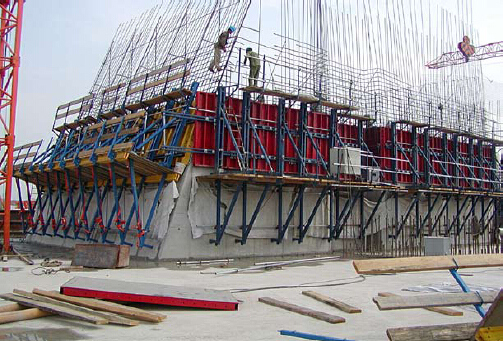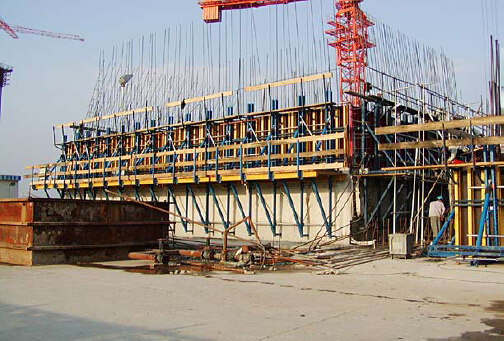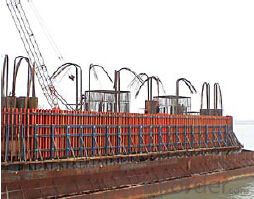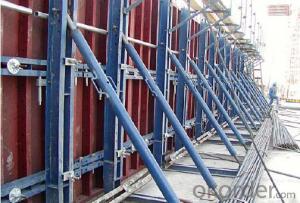Single-Side Climbing Bracket SCB180 for formwork and scaffolding system
- Loading Port:
- Tianjin
- Payment Terms:
- TT OR LC
- Min Order Qty:
- 50 m²
- Supply Capability:
- 1000 m²/month
OKorder Service Pledge
OKorder Financial Service
You Might Also Like
Single-side Climbing Bracket SCB180:
With CNBM SCB 180 climbing systems, the loads from the fresh concrete pressure are transferred through the brackets by means of V-strongbacks and compression braces into the scaffold anchors.
Typical applications for the SCB 180 are dams, locks, cooling towers, pier heads, tunnels, and bank vaults.
The formwork is simply tilted backwards when striking takes place. The 1.80 m wide bracket requires only a minimum of space.
Characteristics:
◆ Economical and safe anchoring
The M30/D20 climbing cones have been designed especially for single-sided concreting using
SCB180 in dam construction, and to allow the transfer of high tensile and shear forces into the still
fresh, unreinforced concrete. Without wall-through tie-rods, finished concrete is perfect.
◆ Stable and cost-effective for high loads
generous bracket spacings allow large-area formwork units with optimal utilization of the bearing
capacity. This leads to extremely economical solutions.
◆ Simple and flexible planning
With SCB180 single-sided climbing formwork, circular structures can also be concreted without
undergoing any large planning process. Even use on inclined walls is feasible without any special
measures because additional concrete loads or lifting forces can be safely transferred into the
structure.


- Q: How does steel formwork affect the overall project cost estimation?
- Steel formwork can have a significant impact on the overall project cost estimation. While it may have a higher upfront cost compared to traditional materials like wood or plywood, steel formwork offers several advantages that can help offset these initial expenses. Its durability and reusability make it a cost-effective choice in the long run as it eliminates the need for frequent replacements or repairs. Additionally, steel formwork enables faster construction times due to its strength and stability, reducing labor costs and potentially accelerating project timelines. Therefore, although steel formwork may contribute to higher upfront costs, it can ultimately lead to cost savings and efficiency improvements, positively impacting the overall project cost estimation.
- Q: Are there any environmental benefits to using steel formwork?
- Yes, there are several environmental benefits to using steel formwork in construction projects. Firstly, steel formwork is highly durable and can be reused multiple times, reducing the need for new formwork materials. This significantly reduces the amount of waste generated during construction, as traditional formwork materials like timber are often discarded after a single use. By using steel formwork, construction companies can minimize their environmental footprint by reducing the amount of waste sent to landfills. Additionally, steel formwork is recyclable, meaning that at the end of its lifecycle, it can be recycled and repurposed into new steel products. This helps to conserve natural resources and reduce the demand for raw materials. Furthermore, the energy required to recycle steel is significantly less than the energy required to produce new steel, resulting in reduced greenhouse gas emissions. Steel formwork also offers advantages in terms of energy efficiency. Compared to traditional formwork materials, steel formwork requires less energy to manufacture and transport, resulting in lower carbon emissions. Furthermore, steel formwork is known for its high strength and rigidity, which allows for the construction of more slender and lightweight structures. This can lead to reduced material consumption and subsequently lower energy requirements for heating, cooling, and lighting in the constructed buildings. Lastly, steel formwork is resistant to moisture, fire, and pests, reducing the need for chemical treatments and preservatives that can harm the environment. This makes steel formwork a more sustainable option and reduces the negative impact on ecosystems and human health. Overall, the use of steel formwork in construction projects offers several environmental benefits, including reduced waste generation, increased recycling opportunities, energy efficiency, and reduced reliance on harmful chemicals. By choosing steel formwork, construction companies can contribute to a more sustainable and environmentally-friendly construction industry.
- Q: How does steel formwork handle different concrete segregation tendencies?
- Steel formwork offers a versatile and durable solution for managing various concrete segregation tendencies. Its strength and rigidity enable it to withstand the pressure exerted by fresh concrete during pouring and vibrating. When confronted with concrete that tends to segregate, steel formwork provides crucial support and containment to prevent the separation of aggregates from the cement paste. The smooth and tight surface of steel formwork aids in retaining moisture within the concrete, preventing excessive water loss and subsequent segregation. Additionally, steel formwork can be easily adjusted and reinforced to accommodate different concrete mix designs and placement techniques. This adaptability allows for the creation of formwork systems that minimize the risk of segregation, guaranteeing a uniform and homogeneous concrete structure. Furthermore, steel formwork possesses resistance to warping and deformation, ensuring the maintenance of formwork shape and stability. This characteristic prevents any potential shifting or movement that could contribute to concrete segregation. Moreover, steel formwork can be designed with features like tie rods and braces, which provide extra support and prevent bulging or bowing of the formwork under concrete pressure. This feature is particularly advantageous when dealing with concrete mixtures that have a high tendency to segregate. To summarize, steel formwork effectively manages various concrete segregation tendencies by offering robust support, preventing excessive water loss, and providing flexibility and adjustability to accommodate different mix designs. Its strength and stability guarantee that the formwork retains the necessary shape and integrity to prevent segregation and produce a uniform and high-quality concrete structure.
- Q: How does steel formwork compare to aluminum formwork?
- In construction projects, two popular types of formwork systems are utilized: steel formwork and aluminum formwork. While both options have their pros and cons, several notable distinctions set them apart. Strength and Durability: Steel formwork boasts exceptional strength and durability, making it ideal for heavy-duty construction projects. It can withstand high load capacities and is resistant to deformation. Conversely, aluminum formwork, although lighter, lacks the same level of strength as steel. It is more suitable for smaller-scale projects that do not require heavy loads. Weight and Handling: Steel formwork is significantly heavier than aluminum formwork. This disparity can make transportation and handling more challenging, demanding more labor and machinery. On the other hand, aluminum formwork, being lightweight, is easier to handle and transport, minimizing the need for additional resources. Cost: Steel formwork tends to be pricier than aluminum formwork due to its superior strength and durability. However, steel formwork has a longer lifespan and can be reused multiple times, potentially making it more cost-effective in the long run. In contrast, aluminum formwork is cheaper initially but may necessitate more frequent replacement due to its lower durability. Versatility and Adaptability: Steel formwork can be tailored to fit various shapes and sizes, providing greater design flexibility. It is highly adaptable, allowing for on-site modifications if necessary. Conversely, aluminum formwork is less versatile and typically comes in standard sizes. Consequently, more planning and precision are required during the design phase. Surface Finish: Steel formwork typically yields a smoother and more uniform surface finish compared to aluminum formwork. This is crucial for projects where the appearance of concrete elements is of utmost importance, such as architectural structures. Environmental Impact: Aluminum formwork is considered more environmentally friendly than steel formwork. Aluminum can be recycled and reused more easily, thus reducing its carbon footprint. Conversely, steel requires more energy and resources for production and recycling. In conclusion, steel formwork and aluminum formwork each possess distinct advantages and disadvantages. Steel formwork excels in strength, durability, and surface finishes but is heavier, costlier, and less environmentally friendly. On the other hand, aluminum formwork is lighter, cost-effective, and easier to handle but lacks equal strength and durability. Ultimately, the choice between the two depends on the specific requirements of the construction project and the priorities of the contractor or builder.
- Q: How does steel formwork handle different concrete slump flow measurements?
- Steel formwork offers versatility and durability when dealing with various measurements of concrete slump flow. Slump flow is a gauge of concrete's consistency and workability, indicating its capacity to flow and fill the formwork. Designed to be rigid and robust, steel formwork can withstand the weight and pressure of poured and cured concrete. This ensures that it effectively contains and supports concrete with different slump flow measurements, preventing any deformation or failure. One advantage of steel formwork lies in its ability to easily adapt to changes in concrete slump flow. It can be adjusted or modified to accommodate varying levels of fluidity and workability. By tightening or loosening the formwork panels, the desired shape and size can be achieved, ensuring proper containment and shaping of the concrete, regardless of its slump flow measurement. Furthermore, steel formwork provides a smooth and uniform surface for the concrete, which is crucial for achieving a high-quality finish. The steel's rigid structure guarantees that the formwork remains in place during the pouring process, minimizing the risk of any movement or displacement that could negatively affect the concrete's performance and appearance. Additionally, steel formwork is resistant to moisture and chemicals, which are often present in concrete mixtures. This resistance ensures that the formwork remains in excellent condition even when exposed to different slump flow measurements, preventing any degradation or corrosion that could compromise its strength and stability. Overall, steel formwork proves to be a dependable and efficient choice for handling different measurements of concrete slump flow. Its strength, adaptability, and resistance to moisture and chemicals make it well-suited for containing and shaping concrete with varying levels of workability, ensuring successful construction projects.
- Q: How does steel formwork handle formwork stripping time?
- Steel formwork is renowned for its durability and strength, characteristics that contribute to its exceptional efficiency in handling formwork stripping time. Unlike traditional wooden formwork, steel formwork has the capacity to endure multiple uses while maintaining its structural integrity. As a result, the stripping time required for steel formwork is significantly reduced when compared to other formwork materials. The rigid construction of steel formwork allows it to bear the weight of concrete and resist deformation during the pouring and curing processes. Consequently, the formwork can be removed more quickly once the concrete has set, as there is less concern about damaging or distorting the formwork. Furthermore, the design of steel formwork incorporates smooth and non-porous surfaces. This characteristic prevents the concrete from bonding with the formwork, facilitating an easier and faster stripping process. Additionally, the smooth surface contributes to a superior finish of the concrete, reducing the need for additional finishing work. Moreover, steel formwork systems often include adjustable features such as adjustable props and modular panels. These features enable easy adjustment and repositioning of the formwork, further enhancing the efficiency of the stripping process. This adaptability allows for faster stripping and reusability of the formwork, resulting in significant time and cost savings. In conclusion, steel formwork excels in managing formwork stripping time due to its durability, strength, and smooth surface. Its ability to withstand multiple uses, resist deformation, and prevent concrete adhesion makes steel formwork highly efficient and time-saving in the construction industry.
- Q: Can steel formwork be used for concrete beams with varying cross-sections?
- Certainly, concrete beams with varying cross-sections can be constructed using steel formwork. The versatility of steel formwork allows for easy adjustment and customization to accommodate different shapes and sizes of concrete beams. This flexibility in formwork design enables the creation of intricate and irregular shapes. Moreover, steel formwork exhibits exceptional strength and durability, making it well-suited for supporting the weight and pressure exerted by concrete during the pouring and curing stages. In conclusion, steel formwork is an excellent option for constructing concrete beams with varying cross-sections, offering adaptability, strength, and reliability.
- Q: Are there any specific considerations for using steel formwork in areas with limited power supply?
- Yes, there are several specific considerations for using steel formwork in areas with limited power supply. Firstly, since steel formwork requires power tools for installation and removal, alternative methods such as manual labor or non-powered equipment may need to be employed. Additionally, the limited power supply may affect the availability of electricity for welding, which is often required for steel formwork assembly. Therefore, alternative joining methods such as bolting or mechanical fastening may need to be explored. Finally, the transportation and storage of steel formwork components in areas with limited power supply may require additional planning to ensure their accessibility and protection.
- Q: Is steel formwork suitable for projects with high concrete strength requirements?
- Indeed, steel formwork proves to be a fitting choice for endeavors demanding robust concrete potency. Renowned for its exceptional fortitude and endurance, steel formwork emerges as an ideal candidate for projects necessitating elevated concrete strength. It deftly endures the concrete's pressure and weight, assuring steadfastness and structural integrity throughout the pouring and curing phases. Furthermore, steel formwork grants the concrete a seamless and uniform surface, crucial in attaining superior strength and excellence in the ultimate outcome. Moreover, the reusability of steel formwork renders it a cost-efficient alternative for ventures requiring substantial concrete strength.
- Q: What are the different types of steel connectors used in steel formwork?
- There are several different types of steel connectors that are commonly used in steel formwork, each serving a specific purpose in ensuring the stability and strength of the structure. Some of the most common types include: 1. Wedge connectors: These connectors are used to secure the form panels together. They feature a wedge-shaped design that allows for easy insertion and tight locking, ensuring a strong connection between panels. 2. Bolt connectors: Bolt connectors are used to join steel formwork components together. These connectors typically consist of a threaded rod and nut, providing a secure and adjustable connection. 3. Pin connectors: Pin connectors are often used to connect steel formwork panels. They consist of a pin and a cotter pin, providing a simple yet effective way to secure the panels in place. 4. Clamp connectors: Clamp connectors are used to hold steel formwork panels together. They typically feature a clamping mechanism that allows for quick and easy installation and removal. 5. Hook connectors: Hook connectors are commonly used to connect steel formwork panels to supporting beams or columns. These connectors feature a hook-shaped design that allows for easy attachment and detachment. 6. Bracket connectors: Bracket connectors are used to provide additional support and stability to steel formwork. They are typically attached to the formwork panels and provide a secure connection to the supporting structure. These are just a few examples of the various types of steel connectors used in steel formwork. The specific type of connector used will depend on the requirements of the project and the formwork design. It is essential to select the appropriate connectors to ensure the safety and structural integrity of the formwork system.
Send your message to us
Single-Side Climbing Bracket SCB180 for formwork and scaffolding system
- Loading Port:
- Tianjin
- Payment Terms:
- TT OR LC
- Min Order Qty:
- 50 m²
- Supply Capability:
- 1000 m²/month
OKorder Service Pledge
OKorder Financial Service
Similar products
Hot products
Hot Searches
















